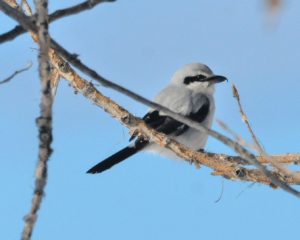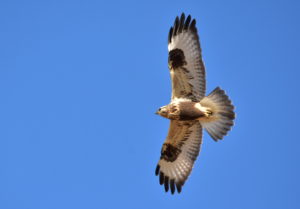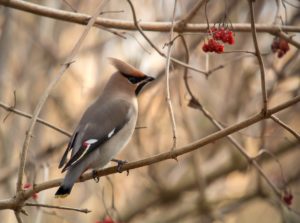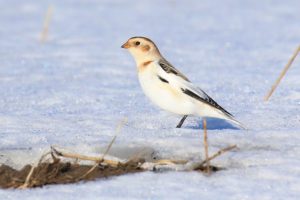By Kyle Kissock |
What birds come to mind when you think of species that are ‘seasonal residents’ of Jackson Hole?
While you’ll likely consider any number of summertime breeders, Osprey, Mountain Bluebird, or vibrant Yellow Warblers, there are a select few species which expand ranges south into Jackson during winter.
These ‘winter residents’ usually depart our valley by springtime for breeding grounds farther north.
This article profiles five of these unique, winter-residents, which Nature Mappers can be on the lookout for now, as the snow flies!
Northern Shrike (Click for Sightings Map)

Photo Credit: John Breitsch, Creative Commons
The Northern Shrike is a predatory songbird which breeds in polar regions. It expands its range south during the winter, where in Jackson Hole, it replaces the Loggerhead Shrike (a summertime breeder) as the resident Shrike species in the valley. Nature Mapping submissions indicate Northern Shrikes are seldom seen in the valley after the first week of April, which is when this species returns to its northern breeding-grounds. Our FOY (First of Year) Northern Shrike was Nature Mapped on December 16, 2019.
Northern Shrikes are generally solitary and are often spotted perched on shrubs or fences in relatively open country. Nature Mapping observations indicate you should look for them in the willows along Moose-Wilson Road and the Gros Ventre during the winter.
Rough-Legged Hawk (Click for Sightings Map)

Photo Credit: Tom Koerner, USFWS
The Rough-Legged Hawk is a tundra-breeding buteo which migrates as far south as Texas for the winter. Although Nature Mappers report Rough-legged Hawks in Jackson Hole throughout the winter, sightings tend to be more regular in our valley from mid-October to early December, and then again in the spring. This is likely due to the maximum snow cover Jackson Hole receives mid-winter, as deep drifts or thick ice accumulation can prevent Rough-legged Hawks from reaching their subnivean food source (generally rodents) under the snowpack. Teton Valley is a great place to consistently observe Rough-legged Hawks all winter. The FOY sighting for this species was Nature Mapped on November 30, 2019 by Frances Clark. Our data indicates this species begins to depart the valley by mid-March.
A medium-sized hawk with dark brown “shoulder patches,” dark wing tips, and a dark belly, Rough-legged Hawks prefer open country and are seldom found in conifer forests. Search for them on telephone polls near Kelly Warm Springs.
Bohemian Waxwings (Click for Sightings Map)

Photo Credit: Frank Vassen, Creative Commons photo
Bohemian Waxwings are a highly nomadic species; according the Cornell Lab of Ornithology. Unlike most other songbirds, they don’t hold breeding territories and their presence any given year can be sporadic. When they expand their range south in the winter, they travel in large flocks in search of fruiting plants, frequently mixing with American Robins or with Cedar Waxwings, which unlike Bohemian Waxwings breed in Jackson Hole and can be spotted here all year. Bohemian Waxwings are seldom seen in the valley after the first week in April. Nature Mappers are yet to report a Bohemian Waxwing sighting in 2020, however, this species often appears in our valley as early as the first week of November.
Look for a chunky, dark, medium-sized songbird likely traveling in a large flock. To differentiate a Bohemian Waxwing from a Cedar Waxwing, look for white on the wings and diagnostic rust-colored patch under the tail. Search for marauding flocks Bohemian Waxwings in town on Crabapple trees.
Common Redpolls (Click for Sightings Map)

Photo Credit: Creative Commons photo
The Common Redpoll is a great example of what is considered an “irruptive” species, meaning it is not uncommon for it to irregularly expand its range into areas where it isn’t usually found (likely in search of food). Frances Clark reported multiple “irruptions” of Common Redpolls in Jackson in recent years, including 2016. Although Common Redpolls are rarely Nature Mapped, at least one Nature Mapper has sighted this species in all but one year since 2011. This species has yet to be recorded by nature mappers this winter. Common Redpolls eat small seeds and are especially attracted to thistle and nyjer feeders, so keep your eye out if you have feeders in your yard . . . our Nature Mapping data shows this bird regularly shows up in town and developed areas.
Look for a siskin-like songbird with a puffy red-chest and a bright red-cap, likely in a flock. Any feeder in Jackson Hole could attract a Redpoll during the right conditions.
Snow Bunting (Click for Sightings Map)

Photo Credit: Creative Commons photo
Our Nature Mapping database contains only 13 reports of Snow Buntings dating back to 2010. Like many of our other winter visitors, this species breeds on the tundra of the high Arctic and expands its range south in the winter. Snow buntings occur exclusively in grassland areas, which in our valley are largely inaccessible during the winter. Teton Valley may be the best place to go to encounter this species, but keep your eyes open when you’re driving out to Kelly or on the National Elk Refuge. The most recent Nature Mapping report of a Snow Bunting was submitted by Tim Griffith on March 4, 2018. Nice spot Tim!
Look for a small, white and black songbird with rusty facial markings, likely traveling with multiple individuals.
Special thanks to Bernie McHugh of the Jackson Hole Bird and Nature Club for his help with his article.
